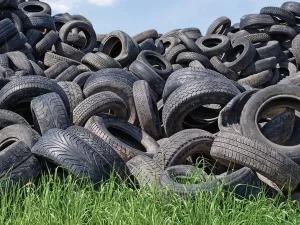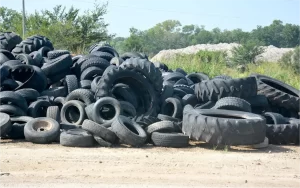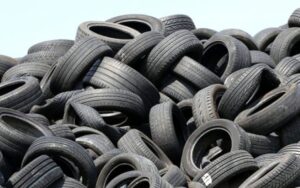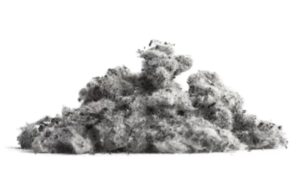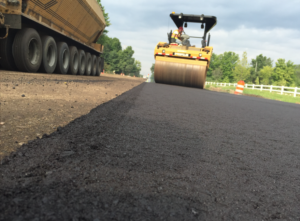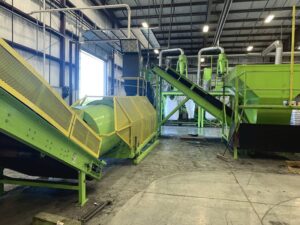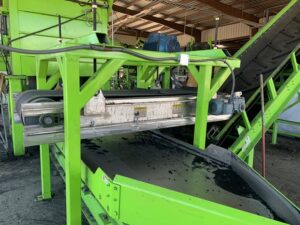
The first piece of machinery in all tire recycling lines is the primary tire shredder. These machines break down large car and truck tires into smaller chunks that can be processed further into a variety of recycling end products. Tire shredders are complex machines. Understanding their basic components and how they work will help you make a better decision when buying a new machine.
How do tire shredders operate?
Tire shredders employ a straightforward yet ingenious mechanism that efficiently utilizes gravity. Standing at a height of up to 20 feet, these shredders employ conveyor belts to transport waste tires to the top of the shredder. Once there, the tires drop into the shredder, where two rotating shafts equipped with sharp blades or teeth tear them apart within the shredding cabinet.
The reliance on gravity ensures a smooth flow of tires through the system, minimizing the risk of jams or overheating. This gravity-driven design not only enhances operational efficiency but also makes tire shredders remarkably energy-efficient—a crucial consideration for tire recycling companies.
Twin shaft shredders, named after their two oppositely rotating shafts with teeth, are a common type of tire shredder. They can also refer to less specialized shredding machines.
What types of tires can shredders process?
While the majority of end-of-life tires come from passenger cars and 16-wheeler trucks, various types of tires are utilized in industrial settings. For instance, farmers employ tractors and harvesters with massive tires, enlarged for increased traction to navigate muddy terrain. Excavating mines necessitates large tires for mining dump trucks carrying heavy loads up steep inclines.
Specialized equipment, often referred to as Off the Road (OTR) shredders, is designed to process these extra-large tires used in industrial applications. OTR shredders are equipped with dimensions and teeth suitable for tearing the thicker rubber of these large tires into pieces.
Do shredders require maintenance?
Yes, regular maintenance is essential for tire shredders, focusing on key components such as teeth, parallel rotors, and the motor. The main costs associated with maintenance involve purchasing new sharp teeth and lubricants. Additionally, keeping the frame free of rust and conducting periodic cleaning are necessary tasks. Despite the workload, tire shredders require relatively minimal maintenance compared to many other industrial machines.
What is the output of a tire shredder?
Primary shredders typically reduce whole tires into tire shreds measuring between five and 15 centimeters. These shreds are often further processed through additional shredders and tire crushers to achieve a more uniform and clean rubber product. The resulting product can be sold as tire-derived fuel or further recycled for use in roads, landscaping projects, playgrounds, and artificial turfs.
The objective of tire shredding is to transform bulky and common waste—end-of-life tires—into a versatile rubber product, extending its useful lifespan and reducing environmental pollution caused by tires in landfills and along roadsides.
Considerations when purchasing tire shredding equipment:
- Suitability for the types of tires to be recycled: Ensure the equipment is appropriate for the kind of tires intended for recycling, avoiding mismatched equipment like using an OTR shredder for common car tires.
- Inclusion of a conveyor belt: Check if the equipment comes with a conveyor belt for efficient transportation of tires to the shredder’s mouth, especially for handling large OTR tires that may require alternative transportation methods.
- Processing capacity: Consider the number of tires the equipment can process per hour. The processing rate directly impacts the potential profitability of a tire recycling line.
- Motor overheating history: Assess whether the motor has a history of overheating, as this can lead to significant delays. Investing in a high-quality shredder and providing adequate ventilation are advisable to optimize performance.
- Design for tire recycling: Opt for a shredder explicitly designed for recycling tires, as opposed to general shredders, to ensure optimal results and reduce the risk of clogging.
Conclusion
Tires can indeed be recycled, but the process involves shredding with specialized machinery. Tire shredders play a vital role by breaking down whole tires into smaller pieces, reducing the volume of waste destined for landfills. Employing compression, shearing, and grinding techniques, tire shredders contribute to achieving consistency in tire pieces—a fundamental step in the tire recycling process.

